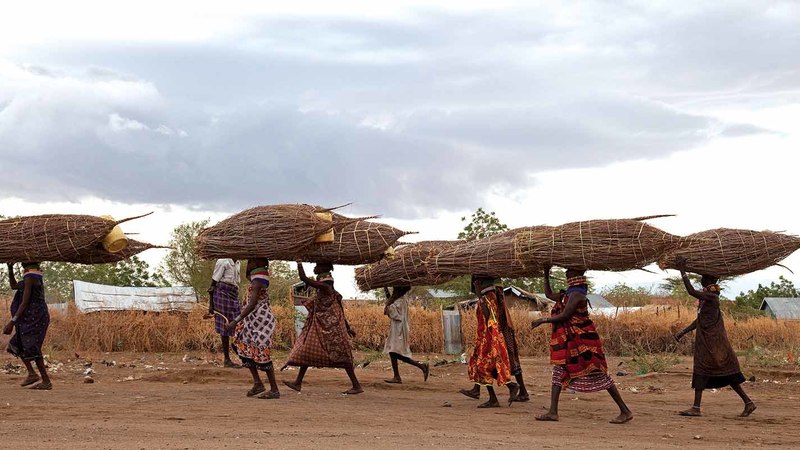It’s late morning and already sweltering as I follow Rahul Oka past the high walls and armed guards of the aid workers’ compound where we’re lodged and onto a baking, shadowless road. A quarter-mile away, over a low, scrub-covered hill, lies Kakuma Refugee Camp, one of the largest refugee camps in the world and, at more than 20 years old, one of Africa’s most enduring. Oka, a Notre Dame anthropology professor, has studied the camp for years and knows its inner workings as well as the authorities who run the place, and maybe better.
Kakuma translates as “nowhere” in Swahili, and that’s not a coincidence. We are on Turkana land, in Kenya’s far northwest, a vast and undeveloped landscape reminiscent of the Mojave Desert. The nomadic Turkana tribe raises livestock, and many members still hew to older ways. Temperatures here often climb past 100 degrees, water and shade are scarce, and the local fauna includes poisonous spiders, scorpions and spitting cobras. It is a harsh place that Oka regards with romantic affection. “The moon in Turkana is the biggest moon I’ve ever seen,” he says with a grin. “You can read by it.”
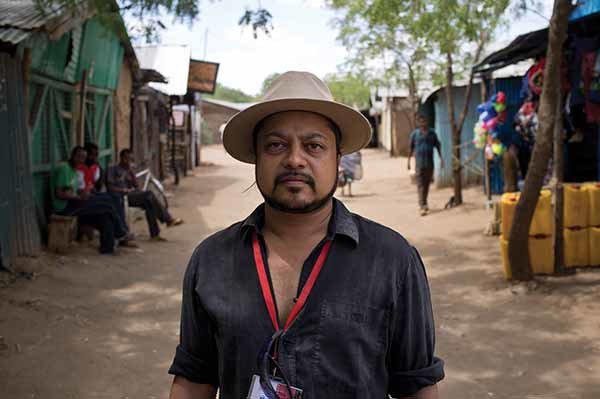
Oka describes his work in Kakuma as ethnography, a study of behavior and culture that weaves the refugees’ economic and social lives into a coherent whole. The residents of the camp are desperately poor, almost totally dependent on small remittances from family outside the camp and the contents of an aid package distributed twice monthly. Out of these meager inputs they’ve built a busy, informal economy, one that allows them little luxuries, such as tea and milk, that keep them from losing hope altogether.
“They are creating these systems where they can feel a little normal,” Oka says. “So they can feel like they are not beggars, that they are not the wretched of the earth.”
The standard techniques of ethnography are observation and interviews, and Oka has done a great deal of both. The day before, we spent a few hours in a dim café in the camp as he hired and trained a couple of new translators, who are crucial for his research. On this spring day he is heading back into Kakuma to interview young men employed in the camp’s underground economy, which is dominated by Ethiopian and Somali trading networks.
Oka turns 40 this year and looks comfortable in the field. His hair is long and pulled back in a ponytail, his beard a little scruffy, his clothes loose, earth-toned and field-worn. He wears a fedora and scuffed leather boots. The fedora is new, picked up from a shop in Nairobi after his wife forgot to pack his “lucky” hat, which has traveled with him to South Sudan, Somalia and other difficult, marginal places. Oka is Indian, from Pune, a major metropolis a couple hours southeast of Mumbai, and speaks in precise, British-accented English. He’s a good storyteller, with a relaxed manner and a laugh that’s big and rounded and a bit regal.
Outside the compound, Oka approaches some teenagers standing in the shade of a thorn tree, beside a couple of Yamaha bikes, and negotiates a lift for us into the camp. The locals call these impromptu motorcycle taxis boda-bodas, and they are Oka’s preferred mode of travel. We climb on, the young men kickstart their bikes, and we buzz off in a cloud of dust.
The bikes dip in and out of ruts and crater-sized potholes, and swerve around some mangy goats and the dirt-covered boys herding them with sticks. The boys smile, wave and shout, and make a half-hearted effort to chase us. Cresting a small hill, we skirt a trash fire smoldering in a ditch that makes my eyes water. Then the road narrows, fences made from thorn tree branches rise around us, and we are in the camp.
Kakuma feels like a labyrinth, one constructed from mud bricks, sheet metal, white and blue United Nations tarps and scavenged wood. Its population is fast approaching 200,000, but the monotonously flat terrain and the camp’s low-slung sprawl makes its actual scale hard to gauge. As we go deeper, the road narrows again and fills with vehicles and animals and variegated crowds of people: wizened Turkana men in loincloths and sandals, gripping walking sticks; Muslim women and girls in head-to-toe black abayas, balancing water jugs on their heads; watchful young men in jeans and high-tops and bright-colored T-shirts. After a while we pass through a tall, rusted metal gate and enter one of the oldest parts of the camp, a busy strip jammed with rough-hewn market stalls, rustic restaurants, cramped barber shops and even a pool hall. The stalls are stacked and hung with goods of all kinds: dried peppers, sacks of cornmeal and potatoes, snack foods, soap, electronics, toys, clothes, phone cards, soft drinks and cigarettes.
Oka knows the area well. “This used to be my main base,” he says. We hop off the bikes and head into Hawassa, an open-air café hidden behind a high wall built from discolored sheet metal panels. Oka’s translator for today, Zakariah, a middle-aged Ethiopian, waits for us inside, and the three of us sit in wobbly chairs that occasionally threaten to buckle on the uneven dirt floor. Ants and flies crawl over the coffee cups and sugar dish, and even in the shade of the canvas roof the air is stifling. Small groups of men puff idly on hookahs and cigarettes, and chew stems of khat, a native shrub with stimulant effects. A few watch us warily. Soon we’re joined by Salat, a young man from Mogadishu.
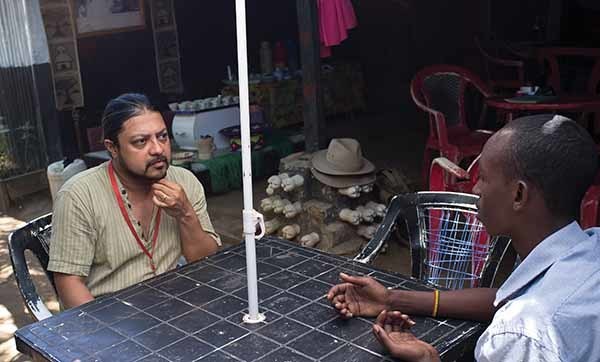
Oka takes out his notepad. “How did you first come to Kakuma?” he asks, and Salat haltingly begins his life story, a tale of upheaval and flight into the desert.
The interview lasts for hours. Under Oka’s patient questioning, Salat slowly opens up about his past and present. He is 23 years old and fled Somalia in 2008, when his country’s long-smoldering civil war again engulfed Mogadishu. He and his parents traveled west, weathering many troubles, and eventually reached Kakuma. About two years ago, he hitched a ride to Juba, the booming capital of the newly independent Republic of South Sudan, 200 miles to the north. Before he left, fellow Somalis warned him that the city was full of thieves, killers and kidnappers.
“You knew about the risk,” Oka says. “Why did you go if you knew about the danger?”
“I went there to look for a life,” Salat says. “The danger I put aside.”
Oka perks up at what he hears next and shoots me a knowing look. In Juba, Salat says, he found work with the help of a Somali businessman, washing trucks and waiting tables. With the money he saved, he joined the trading life, buying cigarettes and other small goods from Somali wholesalers and selling them from a roadside stand near the central market. Robberies were common, as were theft and extortion by the police and soldiers. But the Somali traders in the city look out for each other, he says, interlacing his fingers to illustrate the point. When one of them is robbed, the others help him get back on his feet.
Salat doesn’t realize it, but he’s just brought to life some important truths near the heart of Oka’s research into refugee life. Refugees are the world’s unfortunate among unfortunates: war-traumatized, destitute and exiled to strange lands, living hand-to-mouth at the mercy of relief agencies and indifferent bureaucrats. Yet they retain their human spirit against crushing odds — a will to pull themselves out of the rubble of dashed expectations, to regain some fragment of the lives they lost, to become whole people again.
As Salat tells us, without evident bitterness, everything he built in South Sudan was lost in an instant. Last December, fierce fighting erupted in Juba between rebel militants and government soldiers, and the central market was sacked amid the chaos. Salat fled for his life, taking nothing with him. He caught a bus back to Kakuma, and through the window saw looters carry away the goods from his stand. A few months later, he is back at his old job in the camp, breaking camel bones in a slaughterhouse for meager pay. But he is already on the lookout for new opportunities. “In our country, there is no peace, no place to return,” he says. “So we have to continue our work.”
Salat’s constructive striving represents probably the most valuable resource available to those stuck in camps like Kakuma, Oka tells me later. “This guy was breaking camel bones. But he moved from that to owning his own business,” he says. “That’s the kind of entrepreneurship we need, that can sustain something.”
However, this is precisely the kind of activity discouraged by the United Nations and its partner agencies, under long-established protocols. Modern refugee camps are designed as temporary way stations, a stopover between two points. Their mandate is to fulfill fundamental needs: food, water, shelter — and return refugees back home or resettle them in a new host country as quickly as possible. A few jobs are available with aid agencies, and pay may be $40 a month. But there is no agriculture or manufacturing of any kind. Trade and commerce occur in a murky gray area, hindered, ignored or suppressed.
The result is a stew of dependency, institutionalization and enforced idleness, a soul-crushing limbo that can last for decades. “They are being warehoused,” Oka says.
It is a point with big implications. The number of people displaced globally by conflict is staggering: In 2013, the United Nations counted nearly 17 million refugees, 33 million internally displaced persons and more than a million asylum seekers — a total population of 51 million that is more than six times that of New York City. This year promises to be no better, with new outbreaks of violence or escalations of conflict in such hotspots as Iraq, Ukraine, the Central African Republic and South Sudan.
It was the crisis in South Sudan that drew my attention to East Africa and then to Kakuma and Oka’s research work there. The United Nations established Kakuma in 1991 to manage a crush of refugees fleeing a savage civil war in the Sudan. The conflict and a series of famines it triggered killed upwards of two million people, one of the worst humanitarian disasters of the 20th century.
The war finally ended in 2005 with a U.S.-brokered peace agreement that granted autonomy for southern Sudan, a swath of radically underdeveloped territory about the size of Texas, with a desperately poor population. Six years later, a popular referendum established the independent nation of South Sudan — the world’s newest country. The birth of South Sudan was met with great fanfare, but the fragile state began to veer toward collapse almost immediately, hobbled by corruption and political infighting. In December 2013, a grinding dispute among the country’s ruling political party exploded into open warfare that over the course of several months left major cities in ruins and sent perhaps a million people fleeing for their lives, both inside and outside the country.
By May of this year, when Oka and I arrive at Kakuma, the camp is inundated with South Sudanese, a crush of humanity pushing it far beyond capacity. U.N. figures show the population at nearly 180,000, with more arrivals every week. The camp was designed to hold around 80,000. “Things are at drastic levels,” Oka says. “I think there’s a recognition that the whole place could get unmanageable.”
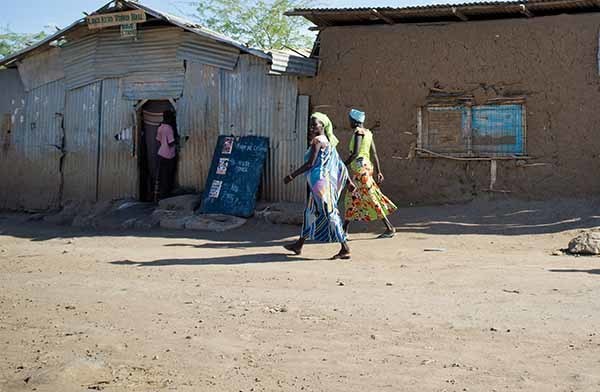
Interestingly, Oka’s research indicates that a hidden force holding Kakuma together during times of stress is a practice camp authorities have long frowned on: the sale of goods from refugee aid packages. The typical package contains only wheat flour, dried whole corn, beans and edible seeds, like sorghum, as well as salt, cooking oil and soap. The food is bland, bordering on inedible and often out of sync with the refugees’ accustomed cuisine. Many camp residents sell some of its contents to black-market traders and use the proceeds to buy more familiar foods and small luxuries, like fish or tea, or sweets and pastries for the holidays.
Refugee life is so hard, and its comforts so few, that the simple act of buying and consuming a favorite food can make life passably tolerable for a time. Across the whole of the camp, these small daily transactions add up to increased social cohesion, Oka says.
Yet the authorities running Kakuma and other camps tend to see the selling of items from the aid packages as refugee ingratitude, and they criticize the practice as wasteful and unscrupulous. “The idea is, you’re selling relief food. You’re not supposed to sell it, you’re supposed to eat it,” Oka says. “There’s also the idea that you don’t need all these other things. You have food, you have shelter — what else do you need?”
Oka probably knows Kakuma as well as any researcher. He first visited the camp in 2007 and published his second major academic paper on its underground economy this March, in the scholarly journal American Anthropologist.
We meet in late May in Nairobi, at a little guesthouse in the city’s Eastleigh neighborhood, an area heavily populated by Somali immigrants. It is a tense time in Kenya; just a few days earlier, two bombs exploded in a crowded market area, killing 10 and injuring 70. It is the latest provocation by Al Shabab, an Islamic militant group based in Somalia and the perpetrators of a string of terrorist attacks across the country. Somali neighborhoods like Eastleigh bore the brunt of the inevitable backlash, as Kenyan police rounded up and detained thousands of innocent Somalis in indiscriminate sweeps. Those who lack papers — or enough bribe money to obtain them — are being deported back to Somalia or sent to Kakuma and Dadaab, a much larger camp near the Kenya-Somali border, Oka tells me. “They have to decide whether Kakuma is worse than Mogadishu,” he says.
The next day we catch an afternoon flight north to Lodwar, a poor and dusty crossroads town, and the following morning hire a car for the drive across the desert to Kakuma. Our driver, Benson, is a soft-spoken Turkana man in a crisp blue dress shirt. The trip to Kakuma takes several hours, on a pothole-rutted, two-lane blacktop through a blazingly hot and unpopulated landscape. About 40 minutes into the drive, we pass through an especially bleak stretch of territory.
“Benson, where are the hills where the bandits are?” Oka asks from the backseat.
“Up there,” Benson says, pointing north at a series of brown, scrub-covered knolls. “Just in front.”
He adds, “Last month they hijacked another vehicle.”
We have nothing to fear, Oka tells me. The bandits almost never strike during the day. But he has run the road late at night and once hitched a ride on a cargo truck that got a flat in the heart of bandit country at 3 in the morning. “The spare tire was under what seemed to be a million bags of concrete,” Oka says.
There have been other close calls, like the time he was robbed at gunpoint while driving through a volatile tribal area near the Kenya-Uganda border. For an anthropologist, brushes with danger can be part of the job; among the legends of the field are men and women who plunged into jungles, swamps and deserts to document the lives of isolated indigenous people, spending months at a time in grueling conditions. “I tip my hat to those anthropologists,” Oka says.
Like many anthropologists today, Oka’s work does not involve hacking through undergrowth with a machete and living in Stone Age villages. His specialty, economic anthropology, involves the study of trade and exchange, consumption, money and markets, often in urban or quasi-urban settings like Kakuma. It is a field whose texts can be somewhat baffling to a novice; one essay Oka emails me begins by promising to explore the “analytical purviews of the interdisciplinary and cross-cultural/temporal approach of economic anthropology.”
In person, Oka is rarely so didactic. Yet his mind is sharp and searching, and at times our ride through the desert takes on the feel of an impromptu lecture, as he riffs on the region’s ancient and recent history, famous archaeological finds, flora and fauna, the ethnography of its tribes, economic and trading patterns, geology and geography. It is where all these fields of science converge, intersect and overlap that great breakthroughs occur, Oka says. “The big questions cannot be handled by any one discipline.”
Oka is a movie buff who sprinkles cinematic allusions throughout our conversation; films are one of his favorite ways to illustrate a complex point to his students, he tells me. He’s a big fan of Avatar, which he calls a spot-on portrayal of the destruction of an indigenous community by modern economic forces. He even credits a childhood classic for steering him toward the anthropologist’s life: Raiders of the Lost Ark, which came out in India in 1983, when Oka was 9 years old. “I saw it five times the first week,” he says. “I even tried to fashion myself a little bullwhip.”
Plenty of children, this writer included, were inspired to plunge into the jungle in search of lost cities after seeing Indiana Jones in action. But Oka had a family edge: His granduncle, Madhukar Dhavalikar, ran an archaeology institute at Deccan College in Pune. “There I met these American graduate students — they had just come back from the field, and they were measuring bones and pot shards,” he says. “I just fell in love with this world. . . . I wanted to be the explorer, the person who was pushing the boundaries of knowledge.”
His father was a successful marine engineer, his mother a homemaker; he has one younger brother. The family lived in “a world of privilege,” Oka says. Observant but open-minded Hindus, his parents sent him to an all-boys Jesuit academy from first grade through high school. The school’s motto was “men for others,” and social justice was stressed there as well as at home.
After earning a degree in anthropology from Lawrence College in Appleton, Wisconsin, Oka eventually began work at the Field Museum in Chicago, assisting a curator, Chapurukha Kusimba, a Kenyan anthropologist. Kusimba helped Oka land a graduate fellowship at the University of Illinois at Chicago and guided him through a rough financial and personal patch around the time of his father’s death. “He kept me alive for six months,” Oka says. “He actually invited me to stay at his house with his family.”
Kusimba was also his doctoral adviser, and the Field Museum became like a second home. Oka even took to sleeping on an air mattress in one of the labs, although he swears that none of the artifacts ever came to life.
Under Kusimba, he studied the archaeology of trade systems, assisting with research into the history of the ivory and slave trade in East Africa. He spent months in the field collecting and analyzing fragments of pot shards to trace the rise and fall of commercial empires. That research gave him a deeper appreciation of the primacy of trade in shaping the fate of societies — and inspired him to look at similar forces at work in the modern world.
It was his wife, Vania Smith-Oka, who helped lead him to Notre Dame. Her work as an anthropologist has focused on women’s health in indigenous communities. In 2007, she was named a faculty fellow at the Kellogg Institute for International Studies, and the following year she was hired as an assistant professor of anthropology. Oka followed her from Chicago, teaching classes in Notre Dame’s anthropology department as an adjunct professor and assisting with the department’s field study programs in East Africa.
In 2009 he was hired to fill the Ford Family assistant professor position in anthropology at Notre Dame. By that time Oka had already begun his research at Kakuma, through a grant from the Field Museum, and impressed the Ford Family hiring committee with his plan to study commerce in the conflict zones of East Africa. “I was interested in trade in unstable areas, what happens when states collapse,” he says.
It is work that continues to attract interest from the right places: In 2013, Oka earned his first grant from the National Science Foundation, the federal agency whose $7 billion budget is a major source of funding for a wide variety of disciplines, including anthropology. That grant will put him back in the field this fall and spring, including two trips to South Sudan.
On our last night together in Kakuma, Oka and I relax with a couple of beers in Catherine’s, a watering hole tucked in an obscure corner of the humanitarian compound. Oka is off to Nairobi in the morning, then to India, where his wife and daughter are living for the summer. He has a busy summer ahead and is finishing a grant proposal for a major new research project, focusing on crony capitalism and cartels in a half-dozen countries.
Earlier that day, we met with a group of new arrivals from South Sudan. They told wrenching tales of the violence engulfing their homeland and the tough transition to refugee life. While they are safe from marauding gunmen, life in the camp is incredibly hard. The food provided in their aid packages is sometimes inedible, they said, and a water shortage means they are entitled to just a few liters per person every day, which they have to walk several miles to obtain.
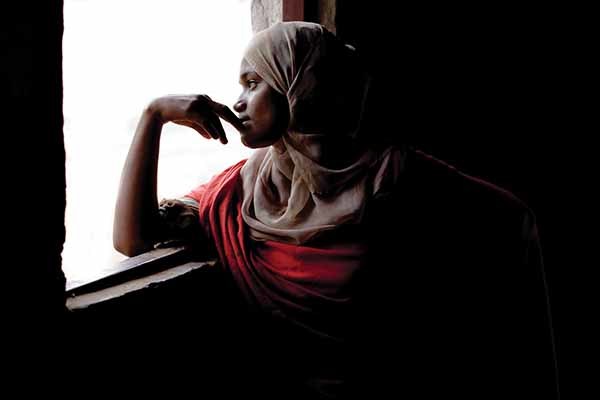
This grim state of affairs is just getting grimmer. Between 2010 and 2012, famine killed a quarter-million people in Somalia, most of them children. A catastrophe of similar scale is probably unfolding in South Sudan, although no one can say for sure. Yet the world media is looking elsewhere, at political problems in Ukraine, Syria, Iraq and Gaza. “Nobody is focusing on South Sudan,” Oka says.
The situation presents a daunting challenge for refugee authorities, who are already faced with pinched aid budgets and growing donor fatigue. Not helping matters, Oka says, is a bureaucracy that resists innovation and hews to a one-size-fits-all approach. “They have no interest or incentive to adjust to local needs,” he says.
Oka sees a better way and is not shy about expressing it. He may be a scientist, but he does not live in an ivory tower. He wants to see the data and patterns his work uncovers used to better the policies and practices of organizations such as the United Nations, and ultimately improve lives. In Kakuma, he says, that means finding ways to unleash the hustle, drive and skills of the refugee population, rather than suppressing them.
- Related articles
- One hand extended to too many
Shifting entrenched bureaucracies like the one at Kakuma can be a Sisyphean task, however. There have been small victories, like the time he tipped off the World Food Program that one of their subcontractors was skimming food from aid packages and selling it on the black market. Within a few months, food distribution was shifted to a new subcontractor. And then there were the memos and informal consultations with officials on the ground, which seemed to reach receptive ears. But little changed in the end. “The system is so entrenched,” he says. “It’s sheer inertia.”
There in Catherine’s, Oka is skeptical that things will ever change. But a few months later, he calls me from Notre Dame with some news. Out of the blue, the United Nations has emailed him, requesting a formal collaboration on their response to the surge of refugees. “This is the first time I’ve actually been invited, not just to send a memo but to have a seat at the table,” he says. “What they want to do is to create resilient communities, instead of warehoused refugees.”
So Oka will head back to Kenya in the fall, to participate in a U.N. conference where major policy changes at Kakuma may finally be hammered out. He’s excited but keeping his fingers crossed. “My natural pessimism aside, I think it’s a great step,” he says.
John Rudolf is a freelance writer based in Portland, Maine.
